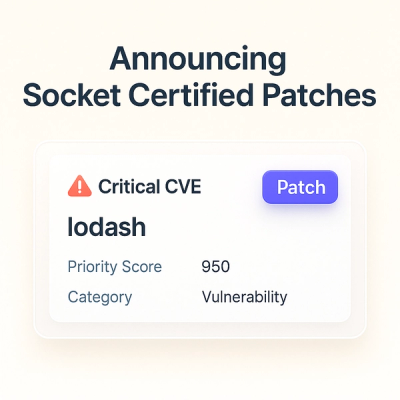
Product
Introducing Socket Scanning for OpenVSX Extensions
Socket now scans OpenVSX extensions, giving teams early detection of risky behaviors, hidden capabilities, and supply chain threats in developer tools.
@clickup/distributed-pacer
Advanced tools
A concurrency aware Redis-backed rate limiter with pacing delay prediction and Token Bucket bursts handling.
See also Full API documentation.
Pacing controls the rate at which concurrent clients perform some operations. It introduces deliberate delays between client requests. The primary goal of pacing is to ensure that the rate of operations (such as outgoing requests) does not exceed a certain threshold (e.g. QPS - "queries per second").
Use Cases:
Notice that the term "pacing" is typically used for outgoing requests from clients (to slow down the requests flow without dropping them), whilst "rate limiting" is for incoming requests on servers (to reject non-conforming requests).
import { DistributedPacer } from "@clickup/distributed-pacer";
import { Redis } from "ioredis";
import { setTimeout } from "timers/promises";
const myIoRedis = new Redis();
async function mySendApiRequest() {
// sends an API request somewhere
}
async function myWorkerRunningOnMultipleMachines() {
while (true) {
const lightweightPacer = new DistributedPacer(myIoRedis, {
key: "myKey",
qps: 10,
maxBurst: 1, // optional
burstAllowanceFactor: 0.5, // optional
});
const outcome = await lightweightPacer.pace(1 /* weight */);
console.log(outcome.reason);
await setTimeout(outcome.delayMs);
await mySendApiRequest();
}
}
DistributedPacer spreads the requests issued by some concurrent workers or
processes uniformly into the future to satisfy the desired downstream QPS
(queries per second) exactly. The implementation is inspired by Leaky Bucket for
Queues algorithm.
The general use case is to introduce some artificial back-pressure when sending requests to external services, to avoid overloading them, e.g.:
Imagine we have a time machine, and we can send requests (events) into the exact provided moment of time in the future. To send a request into the future, the Lua script in Redis returns that moment's timestamp, and then the worker needs to call delay() to wake up at that moment. We also store the last moment of the future to where we sent a previous request, so next requests coming (if they come too quickly) will be sent further and further away.
Another analogy is booking a meeting in the calendar. When a new request arrives, it's not executed immediately, but instead scheduled in the calendar according to the QPS allowance.
Thus, after the returned delayMs is awaited, the request will happen in at
least 1/QPS seconds after the previous request; thus, it will satisfy the target
QPS. Also, if there were no requests in the past within 1/QPS seconds from the
present time, then delayMs returned will be 0.
Imagine that each call to pace(weight) adds weight of water to the bucket of
maxBurst volume, and every second, 1/qps*burstAllowanceFactor of water leaks
out of the bucket at a constant rate (but only when the pacer is idle, i.e.
there are no requests scheduled to the future on top of the bucket). If the
bucket is not yet full (its watermark is below maxBurst level), then the
returned delayMs will be 0, so the worker can proceed with the request
immediately. Otherwise, pacing will start to happen. I.e. we pace only the
requests which cause the bucket to overflow (Leaky Bucket algorithm).
The default value of burstAllowanceFactor is less than 1, which forces the
burst allowance to be earned slightly slower than the target QPS.
Although pacing is the primary use case for this module, it also supports "rate limiting" mode, where it's expected that requests out of quota will be rejected (instead of being delayed). This is useful for handling incoming requests on servers (as opposed to pacing, where the requests originate from workers).
To use DistributedPacer in rate limiting mode, call rateLimit() method on
it. Logically, it works exactly the same way as pace(), but when it returns a
non-zero delayMs, it doesn't alter the state in Redis, assuming that the
request will be rejected and won't contribute to maxBurst allowance.
To utilize the power of Leaky Bucket algorithm (or its equivalent here, Token
Bucket), pass a nonzero value to maxBurst. With the default value (which is
0), no bursts will be allowed, so the requests will need to come in not less
than 1/qps seconds in between.
Disclaimer: here, we use Express just as an illustration: there is obviously a
ready middleware module for Express rate limiting use case. Use
DistributedPacer in other applications, like GraphQL processing, WebSockets,
internal IO services etc.
import { DistributedPacer } from "@clickup/distributed-pacer";
import { Redis } from "ioredis";
import express from "express";
const myIoRedis = new Redis();
express()
.get('/', (req, res) => {
const lightweightPacer = new DistributedPacer(myIoRedis, {
key: "myKey",
qps: 10,
maxBurst: 20,
});
const outcome = await lightweightPacer.rateLimit(1 /* weight */);
if (outcome.delay > 0) {
console.log(outcome.reason);
res.status(429).send(`Rate limited, try again in ${outcome.delay} ms.`);
} else {
res.send("Hello World!")
}
})
.listen(port);
This module is cheap and can be put on a critical path in your application.
DistributedPacer objects are lightweight, so you can create them as often as
you want (even on every request).
Each call to pace() or rateLimit() causes one round-trip to Redis (it runs a
custom Lua function), and the timing of that call is O(1).
If you need to use multiple keys, you can use Redis in cluster mode to spread
those keys across multiple Redis nodes (pass an instance of Redis.Cluster to
DistributedPacer constructor).
FAQs
A concurrency aware Redis-backed rate limiter with pacing delay prediction and Token Bucket bursts handling.
We found that @clickup/distributed-pacer demonstrated a not healthy version release cadence and project activity because the last version was released a year ago. It has 13 open source maintainers collaborating on the project.
Did you know?

Socket for GitHub automatically highlights issues in each pull request and monitors the health of all your open source dependencies. Discover the contents of your packages and block harmful activity before you install or update your dependencies.

Product
Socket now scans OpenVSX extensions, giving teams early detection of risky behaviors, hidden capabilities, and supply chain threats in developer tools.

Product
Bringing supply chain security to the next generation of JavaScript package managers

Product
A safer, faster way to eliminate vulnerabilities without updating dependencies